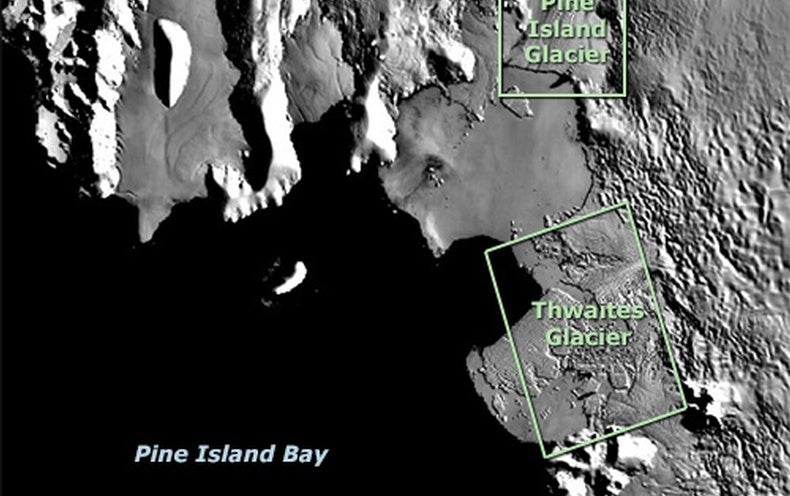
A hole wider than the island of Manhattan is eating away at one of Antarctica’s fastest melting glaciers.
Scientists estimate the enormous cavity—1,000 feet high and 6 miles long—previously contained about 14 billion tons of ice, all of which disappeared within the last three years.
It’s the latest bad sign for the Thwaites Glacier, which has recorded some of the most rapid melt rates out of anywhere in Antarctica. Currently thought to be pouring about 50 billion tons of ice into the ocean each year, scientists estimate Thwaites is responsible for about 4 percent of global sea-level rise all on its own.
And they’re worried it could be getting worse.
Some researchers are concerned that the giant glacier could become increasingly unstable in the coming years, eventually spiraling into a pattern of unstoppable retreat. If that were to happen, it could potentially unleash enough ice to raise global sea levels by 10 feet.
Researchers published their latest findings on the glacier this week in the journal Science Advances, providing an updated look at its patterns of melting and retreat. They used data from a new generation of satellites operated by NASA and Italian and German agencies.
The data allow for “a new level of detail,” according to lead study author Pietro Milillo of NASA’s Jet Propulsion Laboratory. And they’ve revealed some noteworthy surprises: namely, the giant hole.
Underground cavities can play a critical role in the rate at which glaciers melt. They can provide space for seawater to seep underneath the ice and melt it from the bottom up. Glacier experts believe this is the one of the key processes driving ice loss at the Thwaites Glacier.
The hole is startling for its sheer size, but it’s hardly the only one. The satellite data suggest other, smaller cavities are forming in various places beneath the ice, as well. And the intrusion of seawater seems to be driving some unexpected patterns of ice melt.
Generally, scientists expect ice to retreat, or move inland, at the fastest rates in places where the ground beneath the ice slopes downward—it should essentially allow the ice to slip over the bedrock more easily as it slides downhill. Similarly, it seems logical that the ice should be more stable in places where the ground slopes uphill as it moves inland.
But the new study has identified parts of the Thwaites Glacier where the opposite is true. Places that slope upward are actually retreating faster than nearby locations where the ground slopes downward.
The reason appears to be linked to the pattern of underground cavities beneath the ice, which allow warm seawater easier access to some parts of the ice than others. The fastest melting places are the ones most affected by the ocean’s intrusion—even when it looks as though the shape of the bedrock should be stabilizing the ice.
One of these spots is currently melting at the fastest rate of any ice shelf on record in Antarctica, the study suggests.
The findings underscore the huge influence of ocean water on the massive glacier. But the researchers caution that these effects are not all well-represented in the models scientists are using to predict its future.
That’s a big deal when it comes to projecting global sea levels for the coming decades. In some specific spots, the new satellite data indicate that melt rates may be two or three times higher than models have suggested for the same sites.
“We hope that with these kinds of observations, with this data, we hope to improve models,” Milillo said.
He added that the new findings could also help guide a series of recently launched on-site investigations at the glacier.
Last year, the United States and the United Kingdom started a massive research project known as the International Thwaites Glacier Collaboration, aimed at investigating the processes affecting the ice. For at least the next five years, dozens of researchers will work on everything from mapping the bedrock underneath the glacier to measuring melt rates where the ocean touches the ice.
Just this week, part of the team set sail on the U.S. icebreaker Nathaniel B. Palmer to start collecting data on the ocean and the seafloor around West Antarctica.
An important part of these on-the-ground investigations will revolve around processes affecting the grounding line, or the point where the ice attaches to the bedrock below it. Beyond the grounding line, at the edge of the glacier, the ice pulls away from the bedrock and juts out into the ocean as a floating ice shelf. As a glacier melts, its grounding points tend to retreat inland, making them a useful way to monitor how quickly a glacier is changing.
The new study suggests that, in some places, the Thwaites grounding line has migrated several kilometers inland since previous estimates were recorded.
“These kinds of observations will help this U.S.-U.K. expedition to reach the grounding line, to know the grounding line position easily compared to the past,” Milillo said. “So we will basically guide this expedition and provide them information on where the grounding line is, so they can set up their instruments and provide unique information about the Thwaites Glacier.”
Reprinted from Climatewire with permission from E&E News. E&E provides daily coverage of essential energy and environmental news at www.eenews.net.
Bagikan Berita Ini















0 Response to "Huge Hole Discovered Beneath Fast-Melting Antarctic Glacier - Scientific American"
Post a Comment